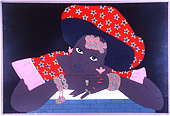Permanent Exhibitions "The Culture of the African Region: The Streets of Senegal."

In modern African societies, some groups still maintain their own culture; however, modernization has exerted considerable influence on some aspects of it. The introduction of a monetary culture in the cities has greatly affected people's lives. We tend to have a negative image of cities in the Third World where unemployment and poverty are endemic, but actually both traditional and modern aspects thrive together in the cities.
 The Topical Exhibit 'The Street of Senegal' shows an aspect of culture first developed by people who live in such cities. Reverse Glass Painting and Tinplate Art are sold on streets and provide color to the capital city, Dakar. They produce a city energized by the pleasure of the artists.
The Topical Exhibit 'The Street of Senegal' shows an aspect of culture first developed by people who live in such cities. Reverse Glass Painting and Tinplate Art are sold on streets and provide color to the capital city, Dakar. They produce a city energized by the pleasure of the artists. Reverse glass paintings are found all over the world, exemplified by European glass icons. It is considered that the art spread from Islam to Senegal. In the latter half of the 19th century, the Senegalese started working on reverse glass paintings and afterwards many artists mastered the art. History, culture, and the daily life of Senegal are painted vividly in many works and have become popular. Today, through exhibitions overseas, reverse glass painting has become all the more popular outside of Senegal.
Reverse glass paintings are found all over the world, exemplified by European glass icons. It is considered that the art spread from Islam to Senegal. In the latter half of the 19th century, the Senegalese started working on reverse glass paintings and afterwards many artists mastered the art. History, culture, and the daily life of Senegal are painted vividly in many works and have become popular. Today, through exhibitions overseas, reverse glass painting has become all the more popular outside of Senegal. Tinplate Art started from gathering rubbish for recycling. It began among the unemployed in the cities who gathered cans to earn a living. Some of those people started to make bags and toys for children from cans, and as a result, gathering rubbish gave birth to a creative art.
Tinplate Art started from gathering rubbish for recycling. It began among the unemployed in the cities who gathered cans to earn a living. Some of those people started to make bags and toys for children from cans, and as a result, gathering rubbish gave birth to a creative art.The world seen in reverse glass paintings is the African society that reflects the life of people in Senegal. They reveal important aspects of Senegalese life, how Senegalese beauty is perceived, and their ideal image of the family. Please experience these messages in the paintings in this exhibit. From the tinplate art, we get a small taste of modern consumerism in Africa from the different kinds of cans and the names of their manufactures.
Person-in-charge of this exhibition:MISHIMA Teiko
(Translated from the April issue of Gekkan Minpaku, 2003)





